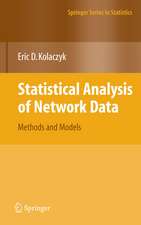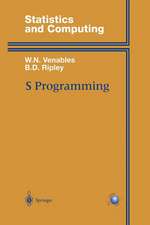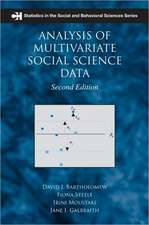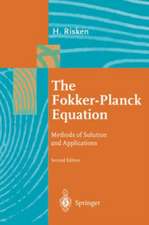Conjugate Duality and the Exponential Fourier Spectrum: Lecture Notes in Statistics, cartea 18
Autor W. Brittonen Limba Engleză Paperback – 14 mar 1983
Din seria Lecture Notes in Statistics
- 15%
 Preț: 631.86 lei
Preț: 631.86 lei -
 Preț: 385.84 lei
Preț: 385.84 lei - 17%
 Preț: 490.19 lei
Preț: 490.19 lei - 17%
 Preț: 460.28 lei
Preț: 460.28 lei - 18%
 Preț: 945.92 lei
Preț: 945.92 lei - 20%
 Preț: 561.42 lei
Preț: 561.42 lei - 18%
 Preț: 943.25 lei
Preț: 943.25 lei - 18%
 Preț: 943.25 lei
Preț: 943.25 lei - 18%
 Preț: 995.97 lei
Preț: 995.97 lei - 15%
 Preț: 641.38 lei
Preț: 641.38 lei -
 Preț: 436.14 lei
Preț: 436.14 lei - 15%
 Preț: 633.53 lei
Preț: 633.53 lei - 15%
 Preț: 658.88 lei
Preț: 658.88 lei -
 Preț: 383.33 lei
Preț: 383.33 lei - 15%
 Preț: 640.71 lei
Preț: 640.71 lei - 18%
 Preț: 947.18 lei
Preț: 947.18 lei - 18%
 Preț: 1007.35 lei
Preț: 1007.35 lei - 18%
 Preț: 942.63 lei
Preț: 942.63 lei - 15%
 Preț: 639.59 lei
Preț: 639.59 lei - 18%
 Preț: 1231.47 lei
Preț: 1231.47 lei - 15%
 Preț: 643.00 lei
Preț: 643.00 lei - 18%
 Preț: 886.62 lei
Preț: 886.62 lei -
 Preț: 383.12 lei
Preț: 383.12 lei - 15%
 Preț: 633.35 lei
Preț: 633.35 lei - 15%
 Preț: 635.65 lei
Preț: 635.65 lei -
 Preț: 393.74 lei
Preț: 393.74 lei - 15%
 Preț: 632.70 lei
Preț: 632.70 lei - 15%
 Preț: 637.28 lei
Preț: 637.28 lei - 15%
 Preț: 702.87 lei
Preț: 702.87 lei - 15%
 Preț: 642.68 lei
Preț: 642.68 lei - 15%
 Preț: 644.63 lei
Preț: 644.63 lei - 15%
 Preț: 645.14 lei
Preț: 645.14 lei -
 Preț: 382.36 lei
Preț: 382.36 lei - 15%
 Preț: 636.30 lei
Preț: 636.30 lei - 15%
 Preț: 647.92 lei
Preț: 647.92 lei -
 Preț: 380.63 lei
Preț: 380.63 lei - 18%
 Preț: 887.05 lei
Preț: 887.05 lei - 15%
 Preț: 634.32 lei
Preț: 634.32 lei - 15%
 Preț: 648.74 lei
Preț: 648.74 lei -
 Preț: 378.92 lei
Preț: 378.92 lei - 15%
 Preț: 648.56 lei
Preț: 648.56 lei - 15%
 Preț: 647.59 lei
Preț: 647.59 lei - 18%
 Preț: 780.37 lei
Preț: 780.37 lei - 15%
 Preț: 641.20 lei
Preț: 641.20 lei - 18%
 Preț: 1102.69 lei
Preț: 1102.69 lei - 15%
 Preț: 643.16 lei
Preț: 643.16 lei -
 Preț: 384.70 lei
Preț: 384.70 lei
Preț: 637.46 lei
Preț vechi: 749.95 lei
-15% Nou
Puncte Express: 956
Preț estimativ în valută:
121.99€ • 126.03$ • 101.53£
121.99€ • 126.03$ • 101.53£
Carte tipărită la comandă
Livrare economică 25 martie-08 aprilie
Preluare comenzi: 021 569.72.76
Specificații
ISBN-13: 9780387908267
ISBN-10: 0387908269
Pagini: 226
Ilustrații: VIII, 226 p.
Dimensiuni: 155 x 235 x 13 mm
Greutate: 0.34 kg
Ediția:Softcover reprint of the original 1st ed. 1983
Editura: Springer
Colecția Springer
Seria Lecture Notes in Statistics
Locul publicării:New York, NY, United States
ISBN-10: 0387908269
Pagini: 226
Ilustrații: VIII, 226 p.
Dimensiuni: 155 x 235 x 13 mm
Greutate: 0.34 kg
Ediția:Softcover reprint of the original 1st ed. 1983
Editura: Springer
Colecția Springer
Seria Lecture Notes in Statistics
Locul publicării:New York, NY, United States
Public țintă
ResearchCuprins
1. Introduction.- 2. Imposing the constraints.- 3. Selecting the objective functional: conjugate duality.- 4. Choosing a truncation point for (c*c)k.- 5. Solving for Solving for $$\vec{\theta}{\rm^{(n)}: n=1}$$.- 6. Solving for $$\vec{\theta}{\rm^{(n)}: n > 1}$$.- 7. Obtaining an initial estimate $$\hat{\vec{\theta}}^{(\rm n)}$$ of $$\vec{\theta}^{(\rm n)}$$.- 8. Numerical asymptotics.- 9. Assessing the sample efficiency of $$\hat{\vec{\rm b}}^{(\rm n)}$$ and $$\hat{\vec{\theta}}^{(\rm n)}$$.- 10. The numerical experiment: preliminaries.- 11. The numerical experiment: results.- 12. Tables and graphs.- Fig. 1 The Sunspot Cycle: 1610–1976.- Fig. 2 The Autocorrelogram of the untransformed data.- Fig. 3 The Autocorrelogram of the transformed data.- Table 1 Summary analysis for fn*.- Table 2 Summary analysis for fn.- Table 3 Order determination of fn* on the Akaike (1977) criterion.- Table 4 Summary analysis of fn*.- Table 5 Asymptotic analysis of Zn (11 ? n ? 20).- Figs. 4–23 Simultaneous plot of fn* (k = 1).- 13. Conclusion.- Appendix A: Comparison of Steffensen(1), simplified N-R(2), unmodified N-R(3), and Laguerre(4) update strategies for solving A(x) = r for x given r = 0(0.01)0.93.- Appendix C: ANSI ‘77 FORTRAN source code listing (MAIN).- Appendix D: ANSI ‘77 FORTRAN source code listing (FOLLOW-UP).- Appendix H: ANSI ‘77 FORTRAN source code (Korovkin).













